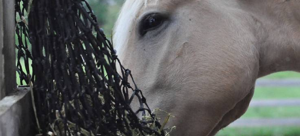 Slow hay feeders are a wonderful development for equines because they allow only a few bits of hay to be withdrawn at a time. This mimics the natural feeding pattern, keeps the horse busy for a long period, and avoids stretches of several hours when the horse has nothing to put in its stomach.
Slow hay feeders are a wonderful development for equines because they allow only a few bits of hay to be withdrawn at a time. This mimics the natural feeding pattern, keeps the horse busy for a long period, and avoids stretches of several hours when the horse has nothing to put in its stomach.
Owners love the nets because they simplify lengthy trailer rides and prevent hours of hungry boredom for stalled horses. Horses should be happy because they can nibble at their hay for hours instead of gobbling it all and then standing around with nothing to eat until the next feeding. The equine digestive tract should be at peace because it receives a slow but continuous supply of fiber.
At first glance, all slow hay feeders seem to be somewhat similar. They all hold a large volume of hay (anywhere from half a bale to several bales, typically) and restrict how much hay a horse can pull out in one bite, usually by having many small openings rather than free access through large holes. There are two basic types—nets or solid material—though there are a few hybrids that combine the designs.
Do an internet search for “slow hay feeders for horses” and you will be faced with an almost infinite array of designs. Many are available commercially, others are homemade, and some make you cringe as you notice the seemingly obvious ways a horse could get trapped, cut, pinched, or otherwise injured when using them.
Before purchasing a slow feeder, do a little research. Check tack and equipment stores, and talk to friends who have slow feeders and ask them what they like and don’t like about the ones they use. Look at catalogs and online photos to compare models.
Keep these factors in mind as you look at various designs:
- Size is obviously important. How many horses will use the feeder at once? To provide sufficient access, you will probably need more than one feeder, even if you have only a few horses.
- Where will the feeder be used? Stall, trailer, and pasture models may need to have different qualities and dimensions.
- How heavy is the feeder? Solid feeders should be made from heavy plastic or a similar material that won’t deform in summer heat or crack in winter temperatures. It will need to be tough enough to withstand kicks and bumps from horses. On the other hand, you will need to move it, turn it over, and clean it from time to time.
- Typical solid feeders consist of a barrel, tub, or box with some sort of movable grid that allows horses to take small bites of hay. Check for sharp edges on the grid’s sides and openings. What happens to the grid as the horses eat part of the hay; or if the horses knock the feeder onto its side or completely over; what will happen if a horse puts a foot into the feeder? How easy will it be to fill, empty, and clean the feeder? If the feeder is outside, is there a way for rain to drain through and away from the hay? Is the feeder so deep that horses might not like to put their heads all the way to the bottom?
Typical net feeders are like traditional hay nets, but with sturdier construction and smaller openings. Check for ways to fill, empty, hang, and carry the net. Is it so big that you can’t move it when it’s full? Is there any chance for a horse, especially one wearing shoes, to get a hoof hung up in the net or its hanging apparatus? Could he get any part of his halter hooked in the net? Even if you can’t imagine this happening, assume that it might occur. Could the hay net still be untied from its suspension if this happened? Be sure the feeder is safe before allowing horses to use it.
Do you have any questions about slow hay feeders? J and J Hay Farms can help! Contact us today.
Article brought to you by Kentucky Equine Research.
